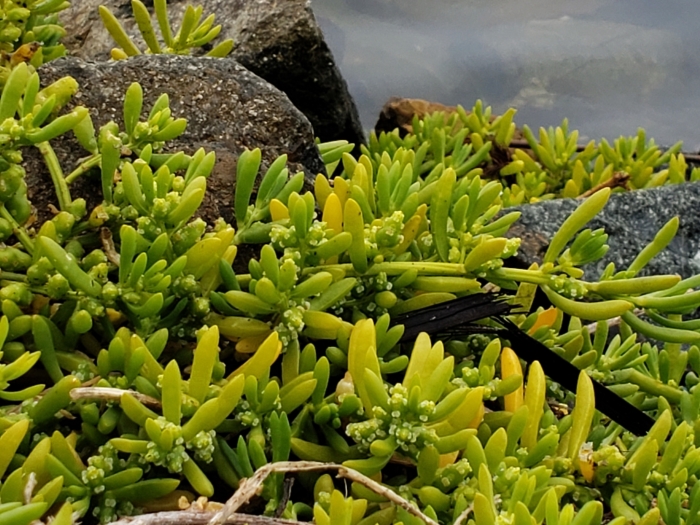Turtleweed
(Batis maritima)
Turtleweed (Batis maritima)
/
/

Steve Addison
CC BY 4.0
Image By:
Steve Addison
Recorded By:
Copyright:
CC BY 4.0
Copyright Notice:
Photo by: Steve Addison | License Type: CC BY 4.0 | License URL: http://creativecommons.org/licenses/by/4.0/ | Rights Holder: Steve Addison | Publisher: iNaturalist | Date Created: 2021-06-17T06:49:59-07:00 |



















































Estimated Native Range
Summary
Batis maritima, commonly known as Turtleweed, is an evergreen subshrub native to coastal regions of the Americas, including salt marshes, brackish marshes, and mangrove swamps. It is particularly adapted to saline environments, often found on the margins of saltpans and wind-tidal flats. As a pioneer species, Turtleweed can quickly cover areas where natural vegetation has been cleared by hurricanes or other disturbances. This long-lived, dioecious, succulent shrub typically grows to 0.1–1.5 m tall and forms dense colonies, providing important habitat for wildlife.
Turtleweed has fleshy, opposite, sessile leaves that contribute to its succulent appearance. The small, white flowers are inconspicuous and wind-pollinated, with self-incompatibility ensuring cross-pollination. In cultivation, Turtleweed is valued for its ability to stabilize soil in coastal gardens and restoration projects. It is also used in salt-tolerant plantings and as ground cover in appropriate conditions. Turtleweed thrives in full sun to part shade and can tolerate a range of water conditions and soil types, including those with varying drainage capabilities. While it is not commonly affected by diseases, it is important to avoid overwatering to prevent root rot.CC BY-SA 4.0
Turtleweed has fleshy, opposite, sessile leaves that contribute to its succulent appearance. The small, white flowers are inconspicuous and wind-pollinated, with self-incompatibility ensuring cross-pollination. In cultivation, Turtleweed is valued for its ability to stabilize soil in coastal gardens and restoration projects. It is also used in salt-tolerant plantings and as ground cover in appropriate conditions. Turtleweed thrives in full sun to part shade and can tolerate a range of water conditions and soil types, including those with varying drainage capabilities. While it is not commonly affected by diseases, it is important to avoid overwatering to prevent root rot.CC BY-SA 4.0
Plant Description
- Plant Type: Subshrub
- Height: 2-4 feet
- Width: 4-8 feet
- Growth Rate: Moderate
- Flower Color: N/A
- Flowering Season: Spring
- Leaf Retention: Evergreen
Growth Requirements
- Sun: Full Sun, Part Shade
- Water: Medium
- Drainage: Fast, Medium, Slow
Common Uses
Erosion Control, Fragrant, Low Maintenance, Salt Tolerant, Water Garden
Natural Habitat
Coastal saline environments, including salt marshes, brackish marshes, and mangrove swamps
Other Names
Common Names: Saltwort, Beachwort, Pickleweed, Barilla, Planta De Sal, Camphire, Herbe-À-Crâbes, Akulikuli-Kai
Scientific Names: , Batis maritima, Batis americana, Batis californica,
GBIF Accepted Name: Batis maritima L.